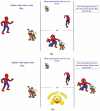Internet-delivered, family-based treatment for early-onset OCD: a preliminary case series
- PMID: 24295036
- PMCID: PMC4269329
- DOI: 10.1080/15374416.2013.855127
Internet-delivered, family-based treatment for early-onset OCD: a preliminary case series
Abstract
Given the burdens of early-onset obsessive-compulsive disorder (OCD), limitations in the broad availability and accessibility of evidence-based care for affected youth present serious public health concerns. The growing potential for technological innovations to transform care for the most traditionally remote and underserved families holds enormous promise. This article presents the rationale, key considerations, and a preliminary case series for a promising behavioral telehealth innovation in the evidence-based treatment of early-onset OCD. We developed an Internet-based format for the delivery of family-based treatment for early-onset OCD directly to families in their homes, regardless of their geographic proximity to a mental health facility. Videoteleconferencing (VTC) methods were used to deliver real-time cognitive-behavioral therapy centering on exposure and response prevention to affected families. Participants in the preliminary case series included 5 children between the ages of 4 and 8 (M Age = 6.5) who received the Internet-delivered treatment format. All youth completed a full treatment course, all showed OCD symptom improvements and global severity improvements from pre- to posttreatment, all showed at least partial diagnostic response, and 60% no longer met diagnostic criteria for OCD at posttreatment. No participants got worse, and all mothers characterized the quality of services received as "excellent." The present work adds to a growing literature supporting the potential of VTC and related computer technology for meaningfully expanding the reach of supported treatments for OCD and lays the foundation for subsequent controlled evaluations to evaluate matters of efficacy and engagement relative to standard in-office evidence-based care.
Figures





References
-
- American Academy of Child and Adolescent Psychiatry, Work Group on Quality Issues Practice parameter for telepsychiatry with children and adolescents. Journal of the American Academy of Child and Adolescent Psychiatry. 2008;47:1468–1483. doi:10.1097/CHI. 0b013e31818b4e13. - PubMed
-
- American Psychiatric Association . Diagnostic and statistical manual of mental disorders. 4th. Author; Washington, DC: 2004. text rev.
-
- American Telemedicine Association Practice guidelines for videoconferencing-based telemental health: October 2009. 2009 Retrieved from http://www.americantelemed.org/docs/default-source/standards/practice-gu.... - PubMed
-
- Banitt Duncan A, Velasquez SE, Nelson EL. Using videoconferencing to provide psychological services to rural youth. Journal of Clinical Child and Adolescent Psychology. in press. - PubMed
Publication types
MeSH terms
Grants and funding
LinkOut - more resources
Full Text Sources
Other Literature Sources
Medical
Miscellaneous
